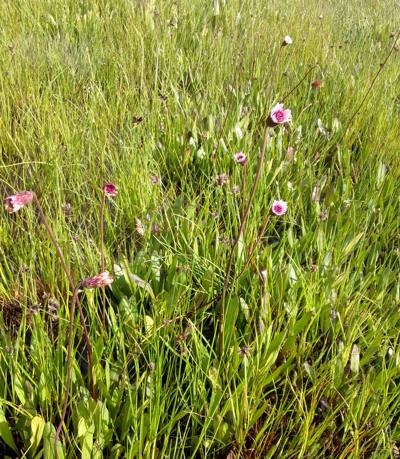Gerbera galpinii
Gerbera galpinii Klatt
Family: Asteraceae
Common names: marsh gerbera
Introduction
Most Gerberas occur in grasslands, a few species are found in forests, while this one is unusual in that it is found in marshy places. Wherever they are found, they will immediately attract your attention with their colourful flowerheads.

Description
Description
Gerbera galpinii, is an upright perennial herb. Some plants grow singly, while others form clumps from short elongated underground stems, from which arise a number of leaves. The short rootstock is thick and silky-woolly with thick roots.
The leaves are erect, up to 250 mm long and 15 mm wide, with some of the petiole-like parts purplish. Leaf blades are leathery, hairless and have smooth, sometimes toothed margins.
The leafless flower-stalk is up to 350 mm tall, the lower part with a few scattered hairs and single head, tinged purplish. The ray flowers (florets on the margin of the flowerhead) are powder-pink, sometimes yellow, and usually female; the disc florets (central florets of the flowerhead) are magenta, and mostly hermaphroditic.
The fruit is a brown, dry, one-seeded capsule, with a ring of fine pinkish brown hairs on one end. Flowering takes place in spring and early summer, between September and December.

Conservation Status
Status
Gerbera galpinii is Red Listed as Least Concern (LC). It has only been collected on four occasions in South Africa, the most recent collections being that of 2003 and 2012. The only possible threat to its continued survival would be habitat loss, since the populations occur in grasslands used for grazing.
Distribution and habitat
Distribution description
Gerbera galpinii is found in Mpumalanga, Swaziland and only one known area in KwaZulu-Natal. It prefers moist or swampy ground and also does well in water. It seems to be frost-tolerant judging from where it is found.

Derivation of name and historical aspects
History
The genus was named after Traugott Gerber, a Polish medical doctor who died in 1743. Gerber's claim to fame was that he started the first botanic garden in Moscow. This species was named for Ernest Edward Galpin who was a banker with no formal botanical training. He collected plants extensively around Barberton in 1889.
Ecology
Ecology
Typical of various members of the Asteraceae family, the fruit of Gerbera galpinii has a ring of fine pinkish brown hairs on one end that aids in seed dispersal through wind.
Uses
Use
This species grows in marshy areas and although not well known it could be introduced into the horticulture industry. There are no other known uses for this plant.
Growing Gerbera galpinii
Grow
Propagate Gerbera galpinii from seed that is less than six months old or by division of clumps at the end of winter. It grows very well in sunny, marshy situations.
References
- Hilliard, O.M. 1977. Compositae in Natal . University of Natal Pres s, Pietermaritzburg.
- Joffe, P. 1993. The Gardeners Guide to South African Plants . Tafelberg, Cape Town.
- Johnson, I. 2010. The genus Gerbera in summer-rainfall South Africa. PlantLife 39 & 40: xx-xx .
Credits
Mkhipheni Ngwenya
KwaZulu-Natal Herbarium
October 2013
Plant Attributes:
Plant Type: Perennial
SA Distribution: KwaZulu-Natal, Mpumalanga
Soil type: Sandy, Loam
Flowering season: Spring, Early Summer
PH: Acid, Alkaline
Flower colour: Purple, Pink, Yellow
Aspect: Full Sun
Gardening skill: Average
Special Features:
Horticultural zones











Rate this article
Article well written and informative
Rate this plant
Is this an interesting plant?
Login to add your Comment
Back to topNot registered yet? Click here to register.